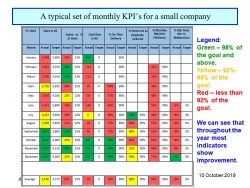Links to articles about Management & communication can be found at the bottom of the article.
A few days ago, I went shopping at a D.I.Y store Upon entering, I was directed to the department I was looking for, but no staff member was present. It took me a few minutes to locate someone who was able to tell me the name of the employee responsible and a few more minutes to find the employee who answered my questions about the product I wanted to buy.
I don’t know about you, but I experience these frustrating episodes time and again. My friends and family members tell me they also experience similar scenarios. Consequently, I very often prefer to buy in three small shops rather than visit one big D.I.Y store.
Do CEOs know what goes on in their shops?
Every now and then we read in the papers about the economic instability of big chain shops. Are CEOs of these chain shops connected to the shop floors? Do they know what goes on inside their shops? Do they visit the sales booths? Do they call on their employees by surprise? Do they witness how each employee functions? After all, this is where the money is made.
I mostly write about engaging employees in the company’s goals. However, it’s a two-way street and the CEO’s connection with the work force is no less important. Management members must be in touch with the basic level of the business: they must meet with production floor workers, accompany sales reps, visit the service centers, etc.
Managers down the managerial line often “save” unwanted information from CEOs. Not all the information is reported upwards in the same way that not all information is cascaded downwards. Obviously, CEOs must trust their managers to report accurately , but they must also meet the employees at the workstations and experience them firsthand.
Herzl (Hertzi) Halevi hides in ambush with soldiers
A few months ago, I participated in a discussion forum with Major General Hertzi Halevi. The event occurred about six months before Halevi was nominated Chief of the General Staff of the IDF.
Halevi served as the Chief Commander of the Southern region at the time when masses of Palestinian demonstrators were rioting by the perimeter fence around the Gaza Strip every Friday afternoon.
The situation was extremely sensitive . On the one hand it was crucial to stop rioters from crossing over the border, on the other hand the troops had to prevent, at all costs unnecessary injuries of innocent people.
Wrong decisions could potentially develop into major security problems which would affect the whole country and the entire Middle East.
Halevi shared with the participants his conversations with the soldiers whom he visited every Friday afternoon.
At the bottom of the commanding line of command were soldiers who had to take major decisions in real time, decisions that could have a massive impact on future events.
I am sure that the general had a clear policy that cascaded down the commanding chain. I am also sure he trusted each of his commanders to report truthful and accurate information. Still, he wanted to meet the soldiers firsthand and give them strength and motivation by listening to them.
If CEOs of the D.I.Y stores were to do what Halevi did, sales and profit would have grown substantially.
Anonymous customers and focus groups
Other ways to test how customers perceive our shops and products is to use anonymous or hidden customers and focus groups.
Anonymous customers usually visit the shop like ordinary customers. Sometimes they might purposely provoke trouble or behave unpleasantly, to test the reaction of the staff and the way they handle unusual situations.
Focus groups are formed to discuss and express an opinion on the products or service the business provides.
Staples, an American office equipment chain shop, uses both these methods. However, these methods cannot replace the CEO’s firsthand impression of the people at work.
During the visit, both the CEO and the employees have direct contact with each other. The employees have a chance to speak to the CEO and the CEO has an opportunity to enhance his influence and increase employees’ motivation.
Salmonella at Straus chocolate factory
Salmonella was found at the Straus chocolate factory about a year ago. The production plant was shut down. From my experience, I can estimate that the bacteria did not suddenly appear one morning. It was probably developing over time.
Three months later, Calcalist informed its readers that Straus used the time of the shutdown to renovate the infrastructure of the production lines, replace the factory’s roof and complete other building works.
I think that the contamination started due to poor maintenance which resulted in birds and rodents nesting in the roof, cracks, and other hidden places. If my estimation is correct, then a breakout was only a matter of time. Perhaps neither the CEO nor any of his management members routinely observed the shop floor.
As manager of Osem Nestle at Yokneam, I used to inspect the production area at least once a week. I would make sure to cover every corner of the plant. I climbed the flour siloes to find the most hidden places and inspect them with my own eyes.
Food manufacturing factories are built with convoluted systems of hot and cold water, air filtration, oil pipes and sometimes flour or other food manufacturing products. These systems are designed away from the production lined, in places where they do not interfere with the production process. For example, in spaces especially created between the roof and the ceiling.
Pigeons and other birds seek these spaces for nesting. If hygiene is not meticulously kept in these places, and indeed all over the premises, contamination can easily occur. If mangers at Straus did not reach these places in person, it is no wonder Salmonella contamination broke out.
CEOs should not centralize the decision-making process
It is important to emphasize that CEOs should not interfere with onsite managers’ decisions or undermine their authority. Random visits are necessary to give the CEO an unmediated view of what happens on the shop floor, the selling points, customer service centers etc. It also creates an important opportunity for him to complement the staff and show appreciation. But CEOs must never give employees direct instructions, make remarks about their conduct, or be involved in employees’ disciplinary issues. His comments should be brought to the onsite managers to act upon. This is the way to support and strengthen middle management.
Micro and Macro
Think of a large wall covered with photographs. To see the whole picture, one must stand back, but the distance blurs the small details. To see every detail, one must get closer. CEOs deal with the big picture. Their position distances them from the small details. Employees, however, see a narrow picture. They know everything there is to know about their workstation, but they don’t see the entire picture.
The small details are the micro. The accumulated knowhow of the employees is a very important micro.
CEOs deal with the macro, the big picture, the company’s strategy. Their solutions may include substantial and costly decisions. CEOs tend to ignore the micro when it’s unknown to them, and that is why they must meet the employees on random, spontaneous visits.
Are you too busy? Remember Commanding Officer, Hertzi Halevi
If you think you are too busy and have no time to visit the workers remember Halevi, who, when serving as Chief Commander of the Southern region, found time to speak with his front-line soldiers every Friday afternoon. Halevi made time to support his soldiers because he appreciated their difficult situation and wanted to be there for them.
Summary and recommendations
In my estimation, if the CEOs of the D.I.Y chains had made time to occasionally visit their stores and personally met the workforce, their shops would have been in a much better position.
The same goes for all businesses. If CEOs try to increase profitability only by looking at the macro level, their chances of finding root cause solutions are very small.
The connection between CEOs and employees is paramount for both sides.
Beware of undermining onsite managers’ authority or interfering with their decisions by giving employees direct orders. Any comment the CEO might have must be cascaded down the management line. That is the way to enhance managers’ power and authority.
Articles about Management & communication
- Why Do Many Managers Resist Improvement Teams and the Information they Provide?
- How to Avoid Miscommunications
- How do we build employee motivation?
- Are there female management positions?
- The Most Common and Successful Management Methods in Israeli Industry - Results of the Managers Survey (Part I)
- The Most Common and Successful Management Methods in Israeli Industry - Results of the Managers Survey (Part II)
- How to Create and Measure Employee Motivation












 My First Book: Manage! Best Value Practices for Effective Management
My First Book: Manage! Best Value Practices for Effective Management